Volunteer to teach young monks and learn about their lifestyle in a fascinating monastery. Nepal has many spectacular Buddhist monasteries. Most of them are Tibetan monasteries opened by Tibetan refugees that fled the Chinese occupation. These monasteries house hundreds of monks enrolled in the life of a monkhood from early in their lives. They study and live in the monastery. They mostly use Tibetan language only during their study and their chances of learning English are very limited.
The tremendous Buddhist presence has led to Buddhist monastery being established in all region of Nepal. Many of these historically significant monasteries are open to the public and located within the Kathmandu valley and surrounding area. In this project you will be educating Buddhist monks in the age range of approximately 5-16 years old. In the monastery at any given time there around 30 to 40 monks, of which there will be 2 classes, one for seniors and one for junior students. A unique opportunities of this placement is the volunteer will have a rare opportunities to witness and participate in traditional Buddhist rituals.
Recently, the Rinpoche or the high lama of the monastery have realized that the monks need to learn English if they are to spread the teaching of Buddhist and communicate effectively with outside people. Hence the monasteries are looking for volunteers to teach English to Buddhist monks. Teaching English to Buddhist monks is an excellent opportunity for volunteers who are interested in Buddhism and culture. In the monastery, volunteers will also have wonderful opportunity to learn vahrayana from of Buddhism and witness colorful rituals and prayers.
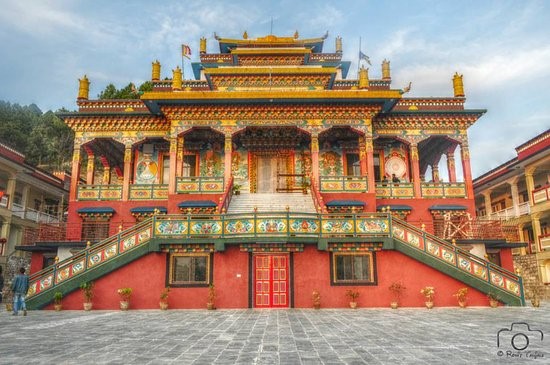
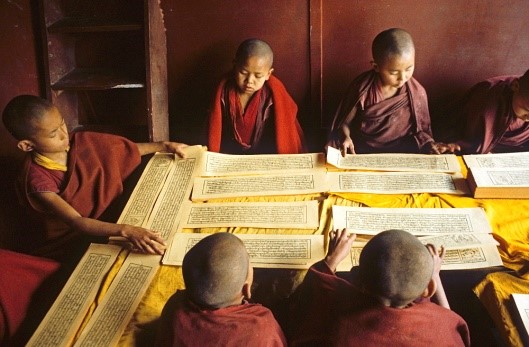
Your activities as a volunteer
Volunteers will primarily work as English instructors either in the schools of the Tibetan children’s village or children home. The monastery are usually very spacious. A central building will house prayer room and the main altar. There will be other building for accommodation, eating and staying. During the teaching you will be encouraged to converse with monks to improve their speech you can talk about things back home and ask them about their childhood and life as monks.
Suggestion
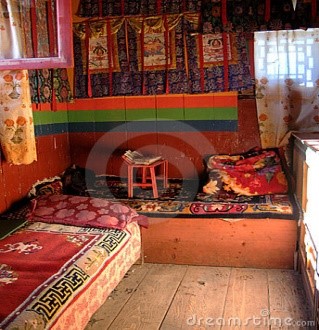
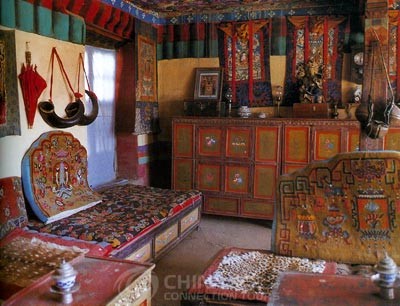
Requirements
There are no specific requirements for the programs. However the best things you can have are patience and a genuine desire to teach and help the children, plus a sense of humor!
Accommodation
A simple room with a bed. We advise you to bring sleeping bag and mosquito net with you. Or you can always buy here which is 2-3 times cheaper than back home.
Meals
Breakfast occurs at 7:00 am and consists of a cup of tea and biscuits. Lunch is served at 11:30 am and usually dall/bhat( rice, lentils and vegetable) dinner is at around 7:00 pm and is once more dall/bhat. The food is very simple but also extremely delicious and filling.
Start date
Are very flexible, minimum time of stay in this program is one weeks and the maximum stay is five months.
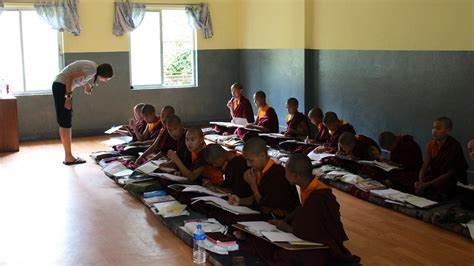
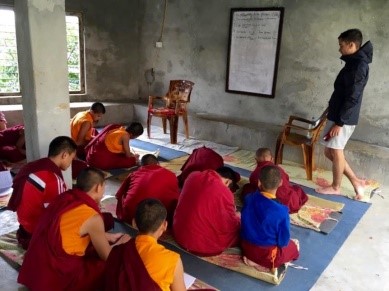
Itinerary
Welcome to Nepal! It’s wonderful to hear that you’re interested in volunteering at a monastery here. Arrived in kathmandu & Monastery Drop (if arrivel before 3 o’clock) or ktm hotel over night.
Arrival at the Monastery On the second day, you will arrive at the monastery in Nepal. You’ll be welcomed by the monks and shown around the premises. You’ll also be introduced to the English language curriculum that you’ll be helping with during your stay.
Teaching English and Helping with Grammar For the next five days, you’ll be working with the monks to teach English and help them with their grammar. The exact schedule will vary depending on the monastery, but you can expect to spend several hours each day working with the monks. Your tasks may include:
- Leading group lessons on English grammar: You’ll be teaching English grammar to groups of monks at the monastery. You’ll likely be using a curriculum that has already been established, so you won’t need to create your own lesson plans but you can make your own too.
- One-on-one tutoring: Some of the monks may need extra help with specific grammar concepts, so you may be assigned to work with them one-on-one.
- Conversation practice: In addition to teaching grammar, you’ll also be helping the monks practice their conversational English skills. This may involve leading group discussions or holding individual conversations.
- Developing lesson plans: If you have experience as a teacher or educator, you may be asked to help develop lesson plans for future volunteers.
In your downtime, you’ll have the opportunity to explore the monastery and surrounding area. You may be invited to attend meditation or prayer sessions with the monks, or you may choose to spend time hiking in the nearby mountains.
Overall, your time at the monastery will be a unique and rewarding experience. You’ll have the chance to make a real difference in the lives of the monks by helping them improve their English skills. And in return, you’ll gain a deeper understanding of their culture and way of life. Enjoy your stay!
Day to leave monastery with bag pack and picking up from the monastery.
- Monastery to Pokhara Flight: The nearest airport to most monasteries in Nepal is the Pokhara Airport. You can take a flight from there to reach Pokhara. The flight takes approximately 25-30 minutes, and the scenic views of the Himalayas are breathtaking.
- 1 Hour Drive by Private Car: Once you reach Pokhara, you can hire a private car for the 1-hour drive to reach the Australian Camp. The road trip is quite picturesque and takes you through beautiful landscapes.
- Hiking to Australian Camp: After the drive, you’ll reach the starting point of the hike to the Australian Camp. The hike takes approximately 1-2 hours, depending on your pace and fitness level. The trek is a bit steep but manageable, and the stunning views of the Himalayas make it all worth it.
- Australian Camp: The Australian Camp is a popular trekking destination in Pokhara, situated at an altitude of 2,100 meters above sea level. The camp offers spectacular views of the Annapurna Range, Machhapuchhre, and Dhaulagiri mountains.
Accommodation
- Hotel in Pokhara ( 1 Night)
Meals Included
- Breakfast, Lunch and dinner.
The hike from Australian Camp to Forest Camp is a popular trekking route in the Annapurna region of Nepal.
The hike begins at the Australian Camp, which is located at an altitude of 2,100 meters. The campsite is easily accessible from Pokhara and offers stunning views of the Himalayan range. The trail from Australian Camp to Forest Camp is relatively moderate and takes around 4-5 hours to complete. The path takes you through dense forests, terraced fields, and several small villages, offering stunning views of the mountains. The hike involves an altitude gain of around 700 meters, with the highest point at Forest Camp, which is situated at an altitude of 2,620 meters above sea level.
Accommodation
- Local tea house ( 1 Night)
Meals Included
- Breakfast, Lunch and dinner
Hiking from Forest Camp to High Camp.
The hike from Forest Camp to High Camp is a popular trekking route in the Annapurna region of Nepal. The hike begins at Forest Camp, which is located at an altitude of 2,620 meters. The campsite is easily accessible from Pokhara and offers beautiful views of the surrounding mountains. The trail from Forest Camp to High Camp is relatively challenging and takes around 4-5 hours to complete. The path takes you through dense forests and rocky terrain, with several steep climbs and descents along the way. The hike involves an altitude gain of around 700 meters, with the highest point at High Camp, which is situated at an altitude of 3,550 meters above sea level. High Camp is a picturesque campsite located amidst stunning mountain views. The campsite offers basic facilities like lodges, restaurants, and restrooms.
Accommodation
- Local tea house ( 1 Night)
Meals Included
- Breakfast, Lunch and dinner.
Hiking from High Camp to Base Camp and back to Badale Danda.
The hike from High Camp to Base Camp and back to Badale Danda is a popular trekking route in the Annapurna region of Nepal. The hike begins at High Camp, which is located at an altitude of 3,550 meters. The campsite offers stunning views of the surrounding mountains from High Camp to Base Camp and back to Badale Danda is challenging and takes around 7-8 hours to complete. The path takes you through rocky terrain, glaciers, and steep ascents and descents. Base Camp is a picturesque campsite located at the base of the Annapurna South peak. The campsite offers basic facilities like lodges, restaurants, and restrooms.The trek from High Camp to Base Camp and back to Badale Danda is considered to be a very challenging trek. The hike involves several steep climbs and descents, as well as a glacier crossing, so it’s important to be physically fit and prepared for the trek.
Accommodation
- Local tea house ( 1 Night)
Meals Included
- Breakfast, Lunch and dinner.
Hiking from Badale Danda to Sidding Village and then by Jeep to Pokhara.
The hike from Badale Danda to Sidding Village is a moderate trekking route in the Annapurna region of Nepal. The hike begins at Badale Danda, which is located at an altitude of 2,520 meters. From Badale Danda to Sidding Village is a moderate hike and takes around 3-4 hours to complete. Sidding Village: Sidding Village is a picturesque village located on the banks of the Modi River. From Sidding Village, you will take a jeep ride to Pokhara, which takes around 2-3 hours to complete. The road is bumpy and rough, so it’s important to be prepared for a rough ride.
Accommodation
• Local tea house ( 1 Night)
Meals Included
• Breakfast, Lunch and dinner.
Pokhara sightseeing and back to Kathmandu by flight/ family sopping for family at thamel.
Pokhara Sightseeing: On Day 13, you can explore the beautiful city of Pokhara and visit some of its famous attractions. Some of the popular places to visit in Pokhara are the Phewa Lake, Mahendra Cave, Devi’s Fall, and the International Mountain Museum. You can also take a short hike to the World Peace Pagoda, which offers stunning views of the city and the Himalayas.
Return to Kathmandu: After sightseeing in Pokhara, you can return to Kathmandu by flight. The flight takes around 25-30 minutes, and offers breathtaking views of the mountains and the valleys.
Family Shopping in Thamel: If you have time, you can also visit Thamel, which is a popular tourist district in Kathmandu. Thamel offers a wide range of shops and boutiques where you can find traditional Nepali handicrafts, souvenirs, clothing, and jewelry. It’s a great place to shop for gifts for your family and friends
Accommodation
- Hotel in Kathmandu ( 1 Night)
Meals Included
- Breakfast, Lunch and dinner.
Final Departure.
On Day 14, you will check out from your hotel in Kathmandu and transfer to the airport for your final departure. Make sure to have all your necessary travel documents, such as your passport and flight tickets, ready. flight and say goodbye to Nepal. You will take with you memories of the stunning landscapes, friendly people, and unique culture of Nepal.We hope you had a wonderful time in Nepal and will come back to visit again soon.
We value $1600.USD per person
COST INCLUDES
- All government and local taxes
- A comprehensive medical kit
- Three Star Hotel in Kathmandu
- Trekking Guide
- All accommodations on the trails and 3 times meals during the trek (staple meal of Daal Bhat for lunch and dinner or any one item from the menu )
- 3 Cups of Tea while on the Trail ( in most of the places where applicable)
- Best available local lodges / Teahouse in mountain
- Taxi to and from airport
- Certificate of trek Completion
- Porters
COST EXCLUDED
- Travel and rescue insurance
- Personal expenses (phone calls, laundry, bar bills, battery recharge, extra porters, bottle or boiled water, shower, mineral water etc)
- Additional food
- Tips for guide
- Anything else that is not mentioned on what is included
